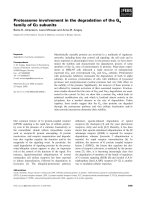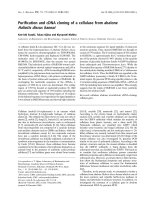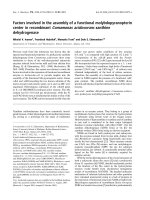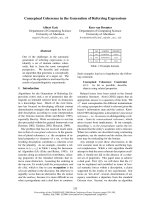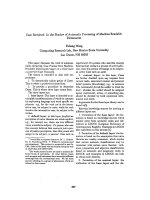Báo cáo khoa học: "Current Research in the Development of a Spoken Language Understanding System using PARSEC*" ppt
Bạn đang xem bản rút gọn của tài liệu. Xem và tải ngay bản đầy đủ của tài liệu tại đây (169.68 KB, 2 trang )
Current Research in the Development of a Spoken Language
Understanding System using PARSEC*
Carla B. Zoltowski
School of Electrical Engineering
Purdue University
West Lafayette, IN 47907
February 28, 1991
1 Introduction
We are developing a spoken language system
which would more effectively merge natural lan-
guage and speech recognition technology by us-
ing a more flexible parsing strategy and utiliz-
ing prosody, the suprasegmental information in
speech such as stress, rhythm, and intonation.
There is a considerable amount of evidence which
indicates that prosodic information impacts hu-
man speech perception at many different levels
[5]. Therefore, it is generally agreed that spoken
language systems would benefit from its addi-
tion to the traditional knowledge sources such
as acoustic-phonetic, syntactic,
and semantic
in-
formation. A recent and novel approach to incor-
porating prosodic information, specifically the
relative duration of phonetic segments, was de-
veloped by Patti Price and John Bear [1, 4].
They have developed an algorithm for computing
break indices using a hidden Markov model, and
have modified the context-free grammar rules to
incorporate links between non-terminals which
corresponded to the break indices. Although in-
corporation of this information reduced the num-
ber of possible parses, the processing time in-
creased because of the addition of the link nodes
in the grammar.
2 Constraint
Grammar
Dependency
Instead of using context-free grammars, we are
using a natural language framework based on the
*Parallel Architecture Sentence ConstraJner
Constraint Dependency Grammar (CDG) for-
realism developed by Maruyama [3]. This frame-
work allows us to handle prosodic information
quite easily, Rather than coordinating lexical,
syntactic, semantic, and contextual modules to
develop the meaning of a sentence, we apply
sets of lexical, syntactic, prosodic, semantic, and
pragmatic rules to a packed structure containing
a developing picture of the structure and mean-
ing of a sentence. The CDG grammar has a weak
generative capacity which is strictly greater than
that of context-free grammars and has the added
advantage of benefiting significantly from a par-
allel architecture [2]. PARSEC is our system
based on the CDG formalism.
To develop a syntactic and semantic analysis
using this framework, a network of the words for
a given sentence is constructed. Each word is
given some number indicating its position rela-
tive to the other words in the sentence. Once
a word is entered in the network, the system
assigns all of the possible
roles
the words can
have by applying the lexical constraints (which
specify legal word categories) and allowing the
word to modify all the remaining words in the
sentence or no words at all. Each of the arcs
in the network has associated with it a matrix
whose row and column indices are the roles that
the words can play in the sentence. Initially, all
entries in the matrices are set to one, indicat-
ing that there is nothing about one word's func-
tion which prohibits another word's right to fill
a certain role in the sentence. Once the net-
work is constructed, additional constraints are
introduced to limit the role of each word in the
sentence to a single function. In a spoken lan-
guage system which may contain several possible
candidates for each word, constraints would also
353
provide feedback about impossible word candi-
dates.
• We have been able to incorporate the dura-
tional information from Bear and Price quite
easily into our framework. An advantage of
our approach is that the prosodic information
is added as constraints instead of incorporat-
ing it into a parsing grammar. Because CDG
is more expressive than context-free grammars,
we can produce prosodic rules that are more ex-
pressive than Bear and Price are able to pro-
vide by augmenting context-free grammars, Also
by formulating prosodic rules as constraints, we
avoid the need to clutter our rules with nonter-
minals required by context-free grammars when
they are augmented to handle prosody. Assum-
ing O(n4/log(n)) processors, the cost of apply-
ing each constraint is O(log (n))[2]. Whenever
we apply a constraint to the network, our pro-
cessing time is incremented by this amount. In
contrast, Bear and Price, by doubling the size of
the grammar are multiplying the processing time
by a factor of 8 when no prosodic information is
available (assuming (2n) 3 = 8n 3 time).
3 Current Research
Our current research effort consists of the devel-
opment of algorithms for extracting the prosodic
information from the speech signal and incor-
poration of this information into the PARSEC
framework. In addition, we will be working to
interface PARSEC with the speech recognition
system being developed at Purdue by Mitchell
and Jamieson.
We have selected a corpus of 14 syntactically
ambiguous sentences for our initial experimen-
tation. We have predicted what prosodic fea-
tures humans use to disambiguate the sentences
and are attempting to develop algorithms to ex-
tract those features from the speech. We are
hoping to build upon those algorithms presented
in [1, 4, 5]. Initially we are using a professional
speaker trained in prosodics in our experiments,
but eventually we will test our results with an
untrained speaker.
Although our current system allows multiple
word candidates, it assumes that each of the pos-
sible words begin and end at the same time. It
currently does not allow for non-aligned word
boundaries. In addition, the output of the speech
recognition system which we will be utilizing will
consist of the most likely sequence of phonemes
for a given utterance, so additional work will be
required to extract the most likely word candi-
dates for use in our system.
4 Conclusion
The CDG formalism provides a very promis-
ing framework for our spoken language system.
We believe its flexibility will allow it to over-
come many of the limitations imposed by natural
language systems developed primarily for text-
based applications, such as repeated words and
false starts of phrases. In addition, we believe
that prosody will help to resolve the ambigu-
ity introduced by the speech recognition system
which is not present in text-based systems.
5 Acknowledgement
This research was supported in part by NSF IRI-
9011179 under the guidance of Profs. Mary P.
Harper and Leah H. Jamieson.
References
[1] J. Bear and P. Price. Prosody, syntax, and parsing.
In
Proceedings of the ~8th annual A CL,
1990.
[2] R. Helzerman and M.P. Harper. Parsec: An archi-
tecture for parallel parsing of constraint dependency
grammars. In
Submitted to The Proceedings o/the
~9th Annual Meeting o.f ACL,
June 1991.
[3] H. Maruyama. Constraint dependency grammar.
Technical Report #RT0044, IBM, Tokyo, Japan,
1990.
[4] P. Price, C. Wightman, M. Ostendorf, and J. Bear.
The use of relative duration in syntactic disambigua-
tion. In
Proceedings o] 1CSLP,
1990.
[5] A. Waibel.
Prosody and Speech Recognition.
Morgan
Kaufmann Publishers, Los Altos, CA, 1988.
354


